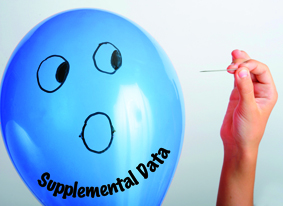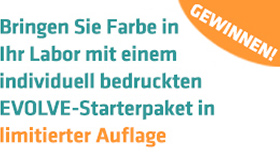 Das Konzept der Supplemental Data als Online-Ergänzung zu gedruckten Forschungsartikeln wird zunehmend faulig. Dies ist unter anderem auch Thema im Editorial der neuesten Ausgabe unserer europäischen Zeitschift Lab Times. Folgender Kommentar wird etwa darin zitiert:
Das Konzept der Supplemental Data als Online-Ergänzung zu gedruckten Forschungsartikeln wird zunehmend faulig. Dies ist unter anderem auch Thema im Editorial der neuesten Ausgabe unserer europäischen Zeitschift Lab Times. Folgender Kommentar wird etwa darin zitiert:
Supplemental materials make sense for things that cannot be printed (videos, for example), or things that are more easily used online (computer code, or big tables of numbers, for example). But I do not like the tendency of journals to move more and more of the meat of a paper to some place separate from the text.
Diese Tendenz zu zunehmend unvollständigen Print-Papern ist offensichtlich — und immer mehr Forscher regen sich inzwischen darüber auf. Auch hier im LJ-Blog zitierten wir unlängst aus einem Kommentar, den die LJ-Redaktion per E-Mail erhielt:
‘Supplementary Data’ — diese Bezeichnung ist übrigens ein zynischer Euphemismus, mit dem schon hunderte von Promotionsprojekten in den Tiefen des Internets zu Grabe getragen wurden. Ich habe schon Publikationen gesehen, die aus 8 Abbildungen im Haupttext und über 20 Abbildungen in den ‘Supplementary Data’ bestanden.
Science Blogger Mike The Mad Biologist bringt das Ganze schließlich auf den Punkt, wenn er schreibt:
If a journal can’t put important information in a paper, then that journal needs to change its format — or go out of business.
Aus diesen Gründen lobten wir am Ende unseres Lab Times-Editorials ausdrücklich die Zeitschrift Journal of Neuroscience, die seit letzten Monat die Möglichkeit ergänzendes ‚Supplemental Material‘ online zu stellen wieder abgeschafft hat. Chefredakteur John Maunsell schrieb hierzu:
Supplemental material also undermines the concept of a self-contained research report by providing a place for critical material to get lost. Methods that are essential for replicating the experiments, analyses that are central to validating the results and awkward observations are increasingly being relegated to supplemental material. Such material is not supplemental and belongs in the body of the article, but authors can be tempted (or, with some journals, even encouraged) to place essential article components in the supplemental material.
Kaum gesagt und getan, setzte jetzt der Open Access-Anbieter BioMed Central dagegen — und bezog in der Debatte grundsätzlich Gegenposition. „In defence of supplemental data files: don’t throw the baby out with the bathwater“ betitelten BioMed Centrals Iain Hrynaszkiewicz (Journal Publisher) und Matt Cockerill (Managing Director) ihre Stellungnahme. Eines ihrer Argumente:
By sharing the underlying data, authors are increasing transparency and promoting reproducibility — one of the foundations of science.
Sie räumen zwar ein, dass:
supplementary material was being used as a space-saving device, and often includes information that would be better presented as part of the article itself.
Dann aber grenzen sie klar ab:
This is certainly a valid criticism of many print journals, which do indeed severely limit the space authors can use to present data and to describe methods. However, because BioMed Central journals are entirely online, they have no such space constraints. If material is best presented in the body of an article, authors can do this. Additional files are intended for use in sharing underlying datasets, movies, 3D-visualizations and other such material that is not easy to present within the article.
Okay, das leuchtet ein! Wer wie BioMed Central nur online veröffentlicht und von daher auch keine Seitenbeschränkungen kennt — für den stellt sich das Problem der Trennung zwischen ‚eigentlichem Paper‘ und ‚Supplemental Material‘ wohl tatsächlich nicht in diesem Maße.
Dies hilft den unzähligen Print-Journals jedoch bei der Lösung des Problems kein bisschen. Und deshalb bleibt Lab Times bei seiner Kür des Journals of Neuroscience zum ‚Journal of the Year‘ — eben wegen dessen Maßnahme gegen den ‚Supplemental Data‘-Wahn. Auch wenn BioMed Central dies als ’surprisingly‘ kommentiert.
Schlagworte: BioMed Central, Lab Times, Online Publishing, Open Access, Paper, Supplemental Data






Auch dem Journal of Experimental Medicine wird es jetzt zuviel mit den Supplemental Data: Enough is Enough.
Deftige Worte, die die Executive Editorin des JEM da von sich gibt – wirklich erfrischend zu lesen!